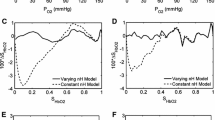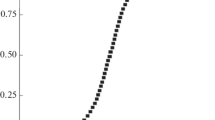Abstract
New mathematical model equations for O2 and CO2 saturations of hemoglobin (S HbO 2 and S HbCO 2) are developed here from the equilibrium binding of O2 and CO2 with hemoglobin inside RBCs. They are in the form of an invertible Hill-type equation with the apparent Hill coefficients K HbO 2 and K HbCO 2 in the expressions for S HbO 2 and S HbCO 2 dependent on the levels of O2 and CO2 partial pressures (P O 2 and P CO 2), pH, 2,3-DPG concentration, and temperature in blood. The invertibility of these new equations allows P O 2 and P CO 2 to be computed efficiently from S HbO 2 and S HbCO 2 and vice-versa. The oxyhemoglobin (HbO2) and carbamino-hemoglobin (HbCO2) dissociation curves computed from these equations are in good agreement with the published experimental and theoretical curves in the literature. The model solutions describe that, at standard physiological conditions, the hemoglobin is about 97.2% saturated by O2 and the amino group of hemoglobin is about 13.1% saturated by CO2. The O2 and CO2 content in whole blood are also calculated here from the gas solubilities, hematocrits, and the new formulas for S HbO 2 and S HbCO 2. Because of the mathematical simplicity and invertibility, these new formulas can be conveniently used in the modeling of simultaneous transport and exchange of O2 and CO2 in the alveoli-blood and blood-tissue exchange systems.
Similar content being viewed by others
References
Adair, G. S. The hemoglobin system. VI. The oxygen dissociation curve of hemoglobin. J. Biol. Chem. 63:529–545, 1925.
Antonini, E., and M. Brunori. Hemoglobin and Myoglobin in their Reactions with Ligands. Amsterdam: North Holland, 1971, pp. 436.
Austin, W. H., E. Lacombe., P. W. Rand, and M. Chatterjee. Solubility of carbon dioxide in serum from 15 to 38 C. J. Appl. Physiol. 18:301–304, 1963.
Bauer C., R. A. Klocke, D. Kamp., and R. E. Forster. Effect of 2,3-diphosphoglycerate and H#x0002B; on the reaction of O2 and hemoglobin. Am. J. Physiol. 224:838–847, 1973.
Baumann, R., H. Bartels., and C. Bauer. Blood oxygen transport. In: Handbook of Physiology, Sect 3: The Respiratory System. Vol IV. Gas Exchange, Bethesda, Maryland: American Physiological Society, 1987, pp. 147–172.
Buerk, D. G. An evaluation of Easton’s paradigm for the oxyhemoglobin equilibrium curve. Adv. Exp. Med. Biol. 180:333–344, 1984.
Buerk D. G. and E. W. Bridges. A simplified algorithm for computing the variation in oxyhemoglobin saturation with pH, PCO2, T and DPG. Chem. Eng. Commun. 47:113–124, 1986.
Easton, D. M. Oxyhemoglobin dissociation curve as expo-exponential paradigm of asymmetric sigmoid function. J. Theor. Biol. 76:335–349, 1979.
Ellis, R. K. Letter to the editor: Determination of PCO2 from saturation. J. Appl. Physiol. 67:902, 1989.
Forster, R. E., H. P. Constantine, M. R. Craw, H. H. Rotman, and R. A. Klocke. Reaction of CO2 with human hemoglobin solution. J. Biol. Chem. 243:3317–3326, 1968.
Forster, R. E. Rate of reaction of CO2 with human hemoglobin. In: CO2: Chemical, Biochemical, and Physiological Aspects, edited by R. E. Forster, J. T. Edsall, A. B. Otis, and F. J. W. Roughton Washington, D.C.: Scientific and Technical Information Division, Office of Technology Utilization, NASA, 1969, pp. 55–59.
Hedley-Whyte, J., and M. B. Laver. O2 solubility in blood and temperature correction factors for PCO2. J. Appl. Physiol. 19:901–906, 1964.
Hill, A. V. The possible effects of the aggregation of the molecules of haemoglobin on its dissociation curves. J. Physiol. 40:iv–vii, 1910.
Hill, E. P., G. G. Power, and L. D. Longo. A mathematical model of carbon dioxide transfer in the placenta and its interaction with oxygen. Am. J. Physiol. Cell. Physiol. 224:283–299, 1973a.
Hill, E. P., G. P. Power, and L. D. Longo. Mathematical simulation of pulmonary O2 and CO2 exchange. Am. J. Physiol. Cell. Physiol. 224:904–917, 1973b.
Hill, E. P., G. G. Power, and L. D. Longo. Kinetics of O2 and CO2 exchange. In: Bioengineering Aspects of the Lung, edited by J. B. West New York: Marcel Dekker, 1977, pp. 459–514.
Huang, N. S., and J. D. Hellums. A theoretical model for gas transport and acid/base regulation by blood flowing in microvessels. Microvasc. Res. 48:364–388, 1994.
Kelman, G. R. Digital computer subroutine for the conversion of oxygen tension into saturation. J. Appl. Physiol. 21:1375–1376, 1966a.
Kelman, G. R. Calculation of certain exponents of cardio-pulmonary function using a digital computer. Respir. Physiol. 1:335–343, 1966b.
Kelman, G. R. Digital computer procedure for the conversion of PCO2 into blood CO2 content. Respir. Physiol. 3:111–115, 1967.
Kelman, G. R. Computer program for the production of O2–CO2 diagrams. Respir Physiol 4:260–269, 1968.
Klocke, R. A. Carbon dioxide transport. In: Handbook of Physiology, Sect. 3: The Respiratory System. Vol IV. Gas Exchange. Bethesda., Maryland: American Physiological Society, 1987, pp. 173–197.
Li, Z., T. Yipintsoi., and J. B. Bassingthwaighte. Nonlinear model for capillary-tissue oxygen transport and metabolism. Ann. Biomed. Eng. 25:604–619, 1997.
Margaria, R. A mathematical treatment of the blood dissociation curve for oxygen. Clin Chem 9:745–791, 1963.
Margaria, R., G. Torelli., and A. Pini. A possible mathematical definition of the O2 dissociation curve from blood or Hb solution. Exp. Med. Surg. 21:127–142, 1963.
O’Riordan, J. F., T. K. Goldstick, L. N. Vida, G. R. Honig, and J. T. Ernest. Modelling whole blood oxygen equilibirum: Comparison of nine different models fitted to normal human data. Adv. Exp. Med. Biol. 191:505–522, 1985.
Popel, A. S. Theory of oxygen transport to tissue. Crit. Rev. Biomed. Eng. 17:257–321, 1989.
Roughton, F. J. W. Transport of oxygen and carbon dioxide. In: Handbook of Physiology, Section 3: Respiration. Volume I. Washington., D.C.: American Physiological Society, 1964, pp. 767–825.
Roughton, F. J. W., Deland, E. C., Kernohan, J. C., and Severinghaus J. W. Some recent studies of the oxyhemoglobin dissociation curve of human blood under physiological conditions and the fitting of the Adair equation to the standard curve. In: Oxygen Affinity of Hemoglobin and Red Cell Acid Base Status. Proceedings of the Alfred Benzon Symposium IV Held at the Premises of the Royal Danish Academy of Sciences and Letters, Copenhagen 17–22 May, 1971, edited by M. Rørth, and P. Astrup–Copenhagen: Munksgaard, 1972, pp. 73–81.
Roughton, F. J. W., and Severinghaus J. W. Accurate determination of O2 dissociation curve of human blood above 98.7% saturation with data on O2 solubility in unmodified human blood from 0° to 37°C. J. Appl. Physiol. 35:861–869, 1973.
Salathe, E. P., Fayad, R., and Schaffer, S. W. Mathematical analysis of carbon dioxide transfer by blood. Math Biosci 57:109–153, 1981.
Severinghaus, J. W., Stupfel, M., and Bradley, A. F. Variations of serum carbonic acid pK with pH and temperature. J. Appl. Physiol. 9:197–200, 1956.
Severinghaus, J. W. Blood gas calculator. J. Appl. Physiol. 21:1108–1116, 1966.
Severinghaus, J. W. Simple, accurate equations for human blood O2 dissociation computations. J. Appl. Physiol.: Respirat Environ Exercise Physiol 46:599–602, 1979.
Severinghaus, J. W. Letter to the editor RE Determination of PO2 from saturation. J. Appl. Physiol. 67:902, 1989.
Sharan, M., and Singh, M. P. Equivalence between one step kinetics and Hill’s equation. J. Biomed. Eng. 6:297–301, 1984.
Siggaard-Andersen, O., Wimberley, P. D., Göthgen, I., and Siggard-Andersen, M. A mathematical model of the hemoglobin-oxygen dissociation curve of human blood and of the oxygen partial pressure as a function of temperature. Clin Chem 30:1646–1651, 1984.
Singh, M. P., Sharan, M., and Aminataei, A. Development of mathematical formulae for O2 and CO2 dissociation curves in the blood. IMA J Math Appl Med Biol 6:25–46, 1989.
Winslow, R. M., Swenberg, M.-L., Berger, R. L., Shrager, R. I., Luzzana, M., Samaja M., and Rossi-Bernardi, L. Oxygen equilibrium curve of normal human blood and its evaluation by Adair’s equation. J. Biol. Chem. 252:2331–2337, 1977.
Winslow, R. M., Samaja, M., Winslow, N. J., Rossi-Bernardi, L., and Shrager, R. I. Simulation of continuous blood O2 equilibrium over physiological pH, DPG, and PCO2 range. J. Appl. Physiol.: Respirat Environ Exercise Physiol 54:524–529, 1983.
Author information
Authors and Affiliations
Corresponding author
Additional information
An erratum to this article is available at http://dx.doi.org/10.1007/s10439-010-9948-y.
Rights and permissions
About this article
Cite this article
Dash, R.K., Bassingthwaighte, J.B. Blood HbO2 and HbCO2 Dissociation Curves at Varied O2, CO2, pH, 2,3-DPG and Temperature Levels. Ann Biomed Eng 32, 1676–1693 (2004). https://doi.org/10.1007/s10439-004-7821-6
Issue Date:
DOI: https://doi.org/10.1007/s10439-004-7821-6




